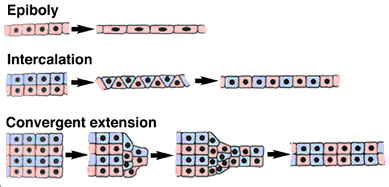

The "morphogenetic repertoire" of cells in the gastrula includes the three additional movements shown on the right. Of these, the specialized form of intercalation known as convergent extension is the most important morphogenetic movement involved in the construction of the primary body axis in amphibians. As we will see, convergent extension is a key event both during gastrulation, when convergent extension of the marginal zone occurs to create the incipient anterior-posterior axis, and during neurulation, when convergent extension of the central region of the neural plate, or notoplate, occurs as the neuraxis elongates and the neural tube closes.
Click on a cell movement below to get a fuller description of what is going on.
| Epiboly | Intercalation | Convergent Extension |

During epiboly, a sheet of cells spreads by thinning. i.e.,
the sheet thins, while its overall surface area increases in the
other two directions. Epiboly can involve a monolayer (i.e. a
sheet of cells one cell layer thick), in which case the individual
cells must undergo a change in shape. In other cases, however,
a sheet that has several cell layer can thin by changes in position
of its cells. In this case, epiboly occurs via intercalation,
one of the other movements described on this page.
Return to top of page.
During intercalation, two or more rows of cells move between
one another, creating an array of cells that is longer (in one
or more dimensions) but thinner. The overall change in shape of
the tissue results from cell
rearrangement. Intercalation can be a powerful means of expanding
a tissue sheet. A specialized form of intercalation is convergent
extension, which is described on this page.
Return to top of page.
During convergent extension, two or more rows of cells intercalate,
but the intercalation is highly directional. Cells converge by
intercalating perpendicular to the axis of extension, resulting
in the overall extension of the tissue in a preferred direction.
If we had a way to label cells from rows on either side of the
axis of extension, they would be found to mix with one another
as a result of these oriented intercalation events.
Return to top of page.